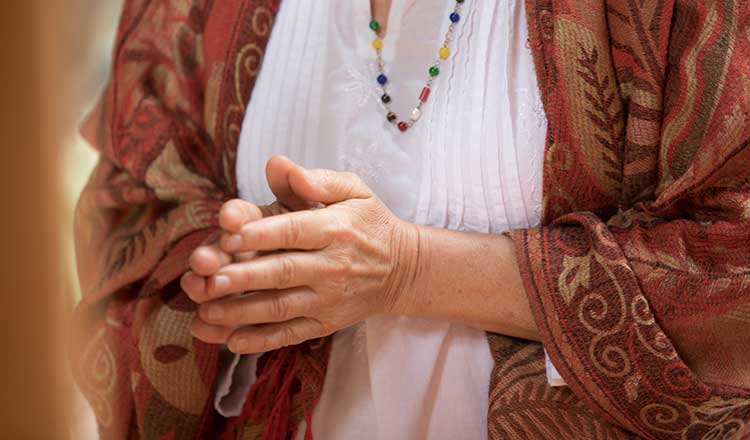Sivananda Bahamas Blog
Expand Your Horizons …
Our Blog
Finding and Feeling Gratitude in a Material World
Many of us have a foot in two different worlds. In the world of yoga, we learn about gratitude, selfless giving, and being grateful for what we have. We give to practice generosity, and to remind ourselves that we already have more than enough. Aspiring yogis are taught to practice non-greed … to live simply without excess, and to be content with the bounty already before us.
In the modern world, we’re taught something different. In an age of materialism and consumerism, we are surrounded by messages that teach the opposite of gratitude: that there is not enough for everyone, we must fight to get ahead, and this is our last chance to buy happiness. We are taught that what we have is old and outdated, and that to truly fulfill our needs we need to buy something newer — something brighter, shiner, and better — and only then can we be happy.
Where does happiness come from?
Many of us know that happiness comes from within … that it can’t be bought, traded, or stashed away for a later date. Happiness comes from our own hearts, minds, and souls. This concept is simple to understand intellectually. But when we’re surrounded by conflicting messages that tell us the opposite, it can be hard to remember the truth.
That’s why gratitude is a practice. It’s a practice of love, thankfulness, and appreciation. It’s a practice of receiving, giving, and acceptance. Without gratitude, we forget how rich we are. Without gratitude, we forget the real treasures in life. Practicing gratitude is one of the most important habits we can build to ensure a lifetime of blessings and miracles.
Practical gratitude for everyday happiness
This past Thanksgiving at the ashram, we invited gratitude experts to teach us practical ways to enforce our inner understanding of gratitude.
Gregg Krech, Buddhist practitioner and author, spent decades studying Buddhism and Japanese psychology before teaching others how to cultivate an authentic sense of gratitude.
“We are a complaint-based culture, always able to find something to feed our discontent,” he says. “Complaining has become the norm, and there is little attention on gratitude.” Gregg says that self-reflection is the key to waking up from this spell of discontent.
In his Gregg’s personal practice, Naikan, you see yourself through the mind’s eye. In this type of reflection, describes three simple but profound questions:
- What did I receive?
- What did I give?
- What troubles or difficulties did I cause?
“A transformative experience starts with a questioning spirit,” he says. “We begin to see suffering in larger context. For instance, when you see what the parents who abused us were going through themselves, this can change the relationship we have with them. We see it from their point of view.”
Gregg says the second antidote to the “complaint culture” is working with attention. “The ability to be grateful first requires that we are attentive,” he says. “Instead of saying ‘I have to’ do this or that, use the language ‘I get to,’” he said. “Our experience of life is not based on our life, but on what we pay attention to. We can find something to be grateful for in every moment of our lives.”
Turning prayers to gratitude
Another presenter in the Thanksgiving symposium, Benedictine Sister Greta Ronningen, cites the words “thank you” as profoundly healing. “There is such joy in these two words,” she says. “Say a thank you prayer, and these words alone can bring gratitude to the heart and spirit.”
Like Gregg, she also acknowledged the many parts of modern culture that oppose gratitude. Many people bully, favor their pride, and pursue pleasure at the expense of others. “But Jesus taught us to help the weak,” she says. This is the yogic practice we need to cultivate — serving others.
“If we want to live in sustained gratitude, we must make an effort to savor the good and notice the sacred,” she says. “When there is a sacred energy around us, we must care for those precious moments.”
Training the mind for gratitude
Cognitive neuroscientist and longtime meditator David Vago, the third presenter of the Thanksgiving symposium, says that the mind can be trained to feel gratitude, and it’s most easily done when we can appreciate those around us. We can use our togetherness to feel more at ease and more grateful.
David offers several ways to train our brains to be in a more permanent state of gratitude. One method is a spiritual benefactor practice in four steps:
- Visualize those who cherish you, gathering all around you.
- Choose one who sends love
- Accept that love.
- Give yourself permission to receive this love.
Training the heart for gratitude
David also cites another method called “loving-kindness,” focusing on well-wishing for others. We can repeat, “May you be safe. May you be happy. May you be healthy. May you live with ease.” This can be repeated again and again. “Apply these words even to people you don’t like,” he advises.
Loving kindness is a state without expectations, without thinking about what is going to happen next. “It has profound benefits on negative thinking habits,” he says. “Think about all the actions of others that contribute to who we are. Even students journaling about gratitude find more positivity.”
Practice gratitude now
Close your eyes and think of something you are truly grateful for. Feel the effects in your body and your heart. Savor this moment, knowing you can recreate it anytime you wish. When you practice gratitude, you live healthier, happier, and with increasing blessings in your life.








